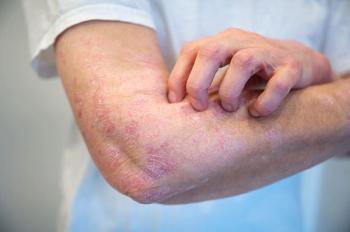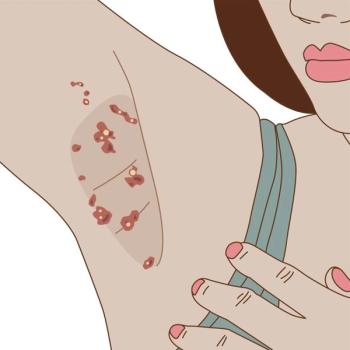
Atypical Tuberculin Skin Test Responses
Tuberculin-type hypersensitivity is characterized by marked spongiotic dermatitis with intraepidermal and subepidermal vesiculation and scattered eosinophils.
Twenty-four hours after receiving a standard 5-unit purified protein derivative of tuberculin (PPD) skin test, a 22-year-old African American man presented with a slightly pink, raised, firm plaque at the site of the injection (A). His previous PPD test results were negative. He denied any constitutional symptoms and rashes. He was otherwise healthy, was not taking any medication, and was HIV-negative.
The plaque had a diameter of 20 mm and a granulomatous appearance with sharp demarcation that did not change after 48 hours of observation. A punch biopsy of the lesion demonstrated marked spongiotic dermatitis with intraepidermal and subepidermal vesiculation and scattered eosinophils, consistent with tuberculin-type hypersensitivity.
During a PPD (Mantoux) test, tuberculin antigen is placed intradermally. A positive response, as denoted by induration, blister formation, or hypersensitivity, represents a type IV (delayed type) hypersensitivity reaction.1 Type IV reactions involve sensitized T lymphocytes that are recruited to the PPD site where cytokines, such as interferon gamma and tumor necrosis factor, are released. Subsequent induration results from vasodilatation, edema, fibrin deposition, and recruitment of other inflammatory cells.
According to the package insert, atypical reactions, such as blisters, granulomas, and local necrosis, after a PPD test are very rare.2 Of the more than 5000 tuberculin skin tests we have administered over the past 5 years, there has been only 1 case of blister formation at the PPD site (B) and 1 exaggerated hypersensitive reaction (see photo A). However, local necrosis has been reported in up to 2.5% of patients with positive responses.3
A new serum-based assay-QuantiFERON-TB-appears to be an effective screening tool for latent Mycobacterium tuberculosis infection. The assay can discriminate responses caused by nontuberculous mycobacteria; interpretation of the results is far more objective than with the skin test.4 Key point: uncomplicated induration typifies the usual positive response. Local necrosis, blister formation, and exaggerated responses can occur and are also considered positive responses.
The opinions or assertions contained herein are the private views of the authors and are not to be construed as official or as reflecting the views of the Department of the Army or the Department of Defense.
References:
REFERENCES:1.American Thoracic Society. Diagnostic standards and classification of tuberculosis in adults and children. Am J Respir Crit Care Med. 2000;161:1376-1395.
2. Tuberculin purified protein derivative (Mantoux) Tubersol® Diagnostic Antigen. Aventis Pasteur, Swiftwater, Pa. Available at:
3. Foll M. Reduction of excessive reactions after tuberculin skin test (Mendel-Mantoux method) [in German]. Gesundheitswesen. 2002;64:544-547.
4. Mazurek GH, LoBue PA, Daley CL, et al. Comparison of a whole-blood interferon gamma assay with tuberculin skin testing for detecting latent Mycobacterium tuberculosis infection. JAMA. 2001;286:1740-1747.
Newsletter
Enhance your clinical practice with the Patient Care newsletter, offering the latest evidence-based guidelines, diagnostic insights, and treatment strategies for primary care physicians.




























































































































































































































































































